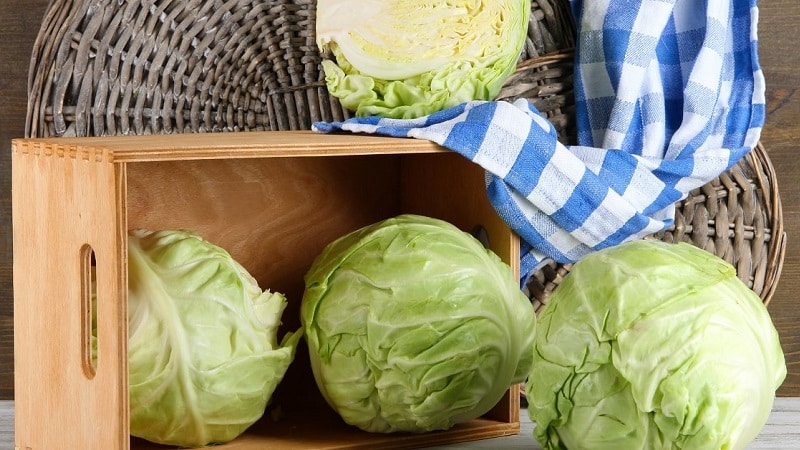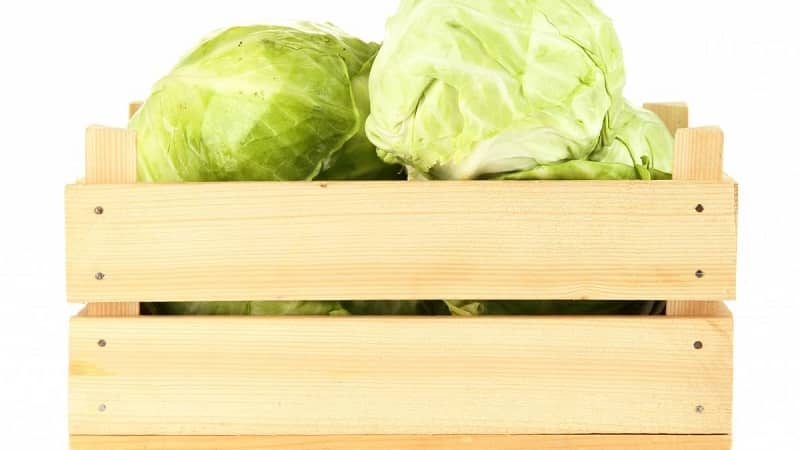Proven ways to store early cabbage until spring
Fresh white cabbage contains many vitamins and beneficial microelements. A wide variety of dishes are prepared from this vegetable. Cabbage grown in your own garden brings the most benefits, since it is not treated with harmful pesticides. But the main thing is to learn how to save forks until spring in order to diversify your diet with a vitamin product in winter.
How to store early cabbage
The length of storage of vegetables largely depends on the selected variety. The late ones remain fresh the longest, but they also have a long growing season. Early cabbage ripens quickly, its leaves are softer and juicier, and the taste is richer.
But many summer residents still prefer mid-season and late varieties. Under certain conditions, they are stored until a fresh harvest. However, few people know that if you create a suitable environment for early varieties, they will also last for at least 2 months without withering or germinating.
To do this, choose the appropriate variety and the optimal time for cutting. After harvesting, the harvest must be sorted and only then stored in a suitable place for storage.

Optimal conditions
During storage, cabbage may begin to rot, dry out, or sprout. These troubles happen if the room maintains an unsuitable microclimate for the vegetable.
Reference. It is best to place the crop in a cellar or basement where there is no access to sunlight.
Providing optimal storage conditions for cabbage is easy:
- It is important to maintain a stable temperature in the room.It should not fall below -1°C and rise above +4°C. If it is colder in the cellar, the leaves will freeze and become unsuitable for consumption. At elevated rates, the crop will begin to rot.
- Humidity – at least 85%, but not more than 95%.
- The room must have good ventilation. In the absence of fresh air, fungi and putrefactive bacteria actively multiply. If it is impossible to arrange forced ventilation in the cellar, the room is ventilated monthly for 2-3 hours.
Selection and preparation of heads of cabbage for fresh storage
It is important to properly prepare not only the room for storing cabbage for the winter, but also the heads of cabbage themselves for storage.
Reference. The keeping quality of a vegetable depends not only on the variety, but also on the growing conditions. It is quite possible for a gardener to ensure that even early varieties remain fresh until spring.
The following rules of agricultural technology will help increase the storage duration:
- Soil selection. Practice shows that cabbage grown on light sandy loam soils is stored much worse than that planted in loam.
- Presence of precipitation. If it rains frequently during the ripening period of the heads of cabbage, you should not count on long-term storage. Moisture penetrates inside the forks, making them looser.
- Fertilizers. Nitrogen fertilizers are often used to accelerate growth. But if the summer resident’s goal is to grow cabbage that will be stored all winter, it is better to avoid these fertilizers. They, like water, make the heads of cabbage looser and saturate the leaves with moisture.
An important role is played by the collection and preparation of the harvest itself. If everything is done correctly, the forks will remain fresh and will not become covered with rot or fungus until spring.
Harvest cutting rules
If the weather conditions for cutting the crop are chosen incorrectly, after a while the heads of cabbage will crack.
Important! The crop is not afraid of frost, so if early cabbage seedlings were planted at the end of summer and managed to ripen before autumn, it is better to wait until the daytime temperature drops or even light frosts. Then the vegetable will be preserved much better.
Other harvesting tips:
- Weather. Heads of cabbage are cut on a dry and sunny day. If it has rained before or drops of dew have accumulated on the leaves, it is better to wait until it dries completely. Otherwise, the crop will have to be dried additionally before storing.
- Selecting a tool. The forks are cut with a very sharp knife. You cannot break out the vegetable by hand. This will cause it to suffer serious mechanical damage and quickly rot.
- Length of the stalk. Ideally – 3-4 cm, minimum – 2 cm.
The top leaves are not removed after cutting the cabbage. In the future, they are not eaten, but they perform a protective function.

The harvested crop must be sorted and the defective forks set aside:
- Instances with any mechanical damage: cracks, dents from hail or accidental cuts.
- Frozen and cracked from excess moisture.
- Cabbage damaged by insects should also not be stored. Underdeveloped vegetables that have not reached technical maturity at the time of harvest are also considered defective.
Such specimens cannot be stored in the basement. They will quickly rot and ruin the rest of the harvest. It is better to finely chop them and ferment or pickle them.
Suitable varieties
Early cabbage reaches full technical maturity by the end of June. It has thin leaves and not very dense heads of cabbage, so it is not possible to preserve this vegetable until spring.
Advice. For residents of regions with warm climates, it is better to plant seedlings not in the spring, but in the middle or end of summer. Then in August–September the second harvest is harvested, which can still be preserved for several months.
Most summer residents prefer not to plant early cabbage seedlings in several passes, but to place early, mid-season and late varieties on the plot. The latter ones are stored the longest. If the variety is chosen correctly, the heads of cabbage will remain fresh and firm for 8 months.
The varieties Amager, Kamennaya Golova, Vyuga, Belosnezhka and Podarok are considered the hardest and keepiest. They are recommended to be planted for long-term storage.
Storage space
The best place to store cabbage heads is considered to be a cool cellar or basement with good ventilation. But only owners of private houses have such premises. Residents of city apartments have to use other options.

Fridge
Several self-grown forks will be successfully stored on the bottom shelf refrigerator.
Reference. Modern models have a so-called freshness zone. It is best suited for cabbage, but if the refrigerator is old, put the heads of cabbage on the bottom shelf.
To keep the vegetable fresh longer, it is wrapped in paper or cling film. In the latter case, make sure that it fits tightly to the leaves, otherwise condensation will begin to accumulate under it. If this has already happened, the film is changed.
Paper is a more reliable option. The heads of cabbage are first wrapped in it and then placed in a plastic bag with a small hole for ventilation. The paper will have to be changed periodically, as it will absorb excess moisture and accumulated condensation.
Balcony

A balcony is a universal room for a city dweller. If you organize the space correctly, the entire harvest from the dacha will be successfully preserved here.
To store cabbage on the balcony, forks are also wrapped in paper or cling film. It is better to place vegetables in special thermal containers or wooden boxes insulated with foam plastic.
Cellar
A basement or cellar is the best place to place cabbage, but provided that the room has ventilation and the temperature does not rise above +4°C.
It is important that the cellar is dry. Otherwise, the forks will begin to rot or become moldy. It is better to lay out vegetables on wooden racks or place them in boxes in one layer so that individual forks do not touch. With this placement, one rotten vegetable will not infect the others so quickly.
House/apartment
In an ordinary house or apartment it will not be possible to preserve cabbage for a long time. The temperature in living areas is too high, and the leaves of the vegetable quickly begin to dry out and wither.
Storage methods
The easiest way to store cabbage is in cardboard boxes or wooden boxes.
The main thing is to arrange the vegetables in one layer and make sure that they do not touch each other.

But there are other options:
- On a sand bed. A wooden box is filled with a 25 cm thick layer of sand. The heads of cabbage are simply buried in the sand, leaving the stalk on the surface.
- In clay. To prepare mash, two parts clay are diluted with one part water. Coat the forks with the resulting mixture and allow the clay to dry completely. In this state, the vegetables are laid out on the cellar shelf, but they still should not touch.
- Aweigh. For this method, when harvesting, stalks 8-10 cm long are left. A rope is tied to them and the heads of cabbage are hung, hooking the ropes onto the nails.Individual forks are placed at a distance from each other so that they do not touch in any way.
If there is a lot of sand and a large box, the cabbage is completely immersed in it. To do this, first pour a layer of sand into the container, then lay out the cabbage in one row and sprinkle it with sand again. Lay out the second layer in the same way, and so on, without allowing the individual forks to touch.
How long does early cabbage last?
Early cabbage is not intended for long-term storage. Even if you follow all the tips above, there is no guarantee that the forks will not start to rot. Therefore, most summer residents still prefer to plant late varieties separately. They are harvested in October, and if stored properly, the cabbage remains fresh until spring.
An alternative method is conservation.
If your efforts are unsuccessful and some of the cabbage in the cellar begins to rot, you can resort to an alternative storage option - conservation.
In this sense, cabbage is a universal vegetable. Based on it they prepare canned vegetable salads, marinate it with the addition of mushrooms and simply ferment it in barrels. In terms of beneficial properties, such a vegetable is practically not inferior to fresh, and a wide selection of recipes for winter preparations diversifies the winter diet.
This is interesting:
The best ways to preserve cauliflower for the winter at home.
Conclusion
Early cabbage is valued for its early ripening and juiciness. But it is not always suitable for long-term storage. To keep the forks fresh and crispy for a long time, it is important to assemble them correctly, prepare a room with a suitable microclimate and select containers for placing the heads of cabbage.
If these conditions cannot be met, the cabbage is processed using one of the many recipes for preparations for the winter.